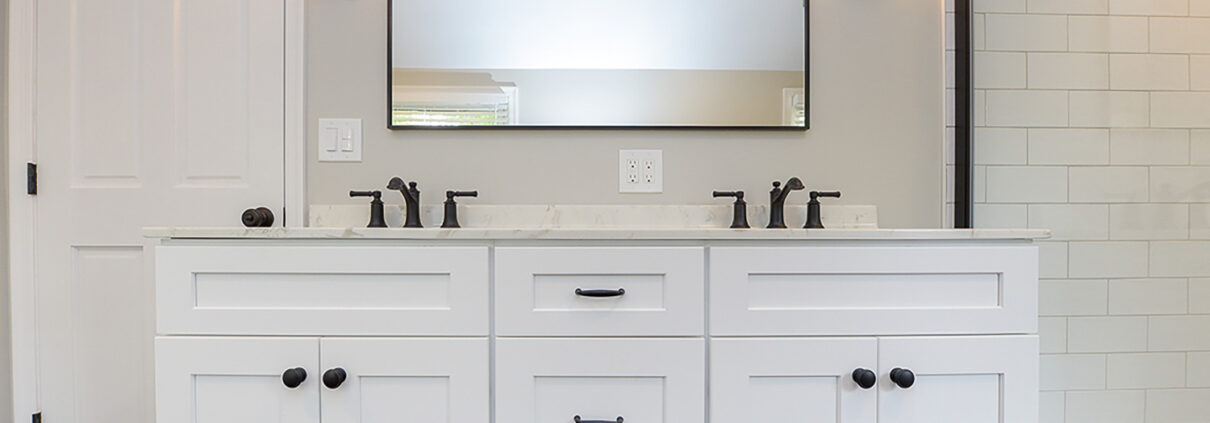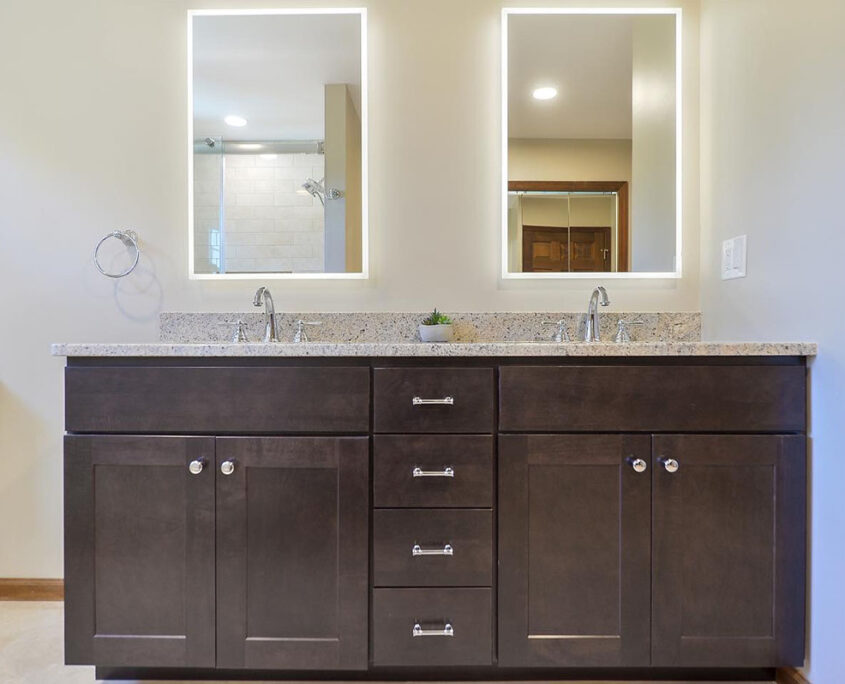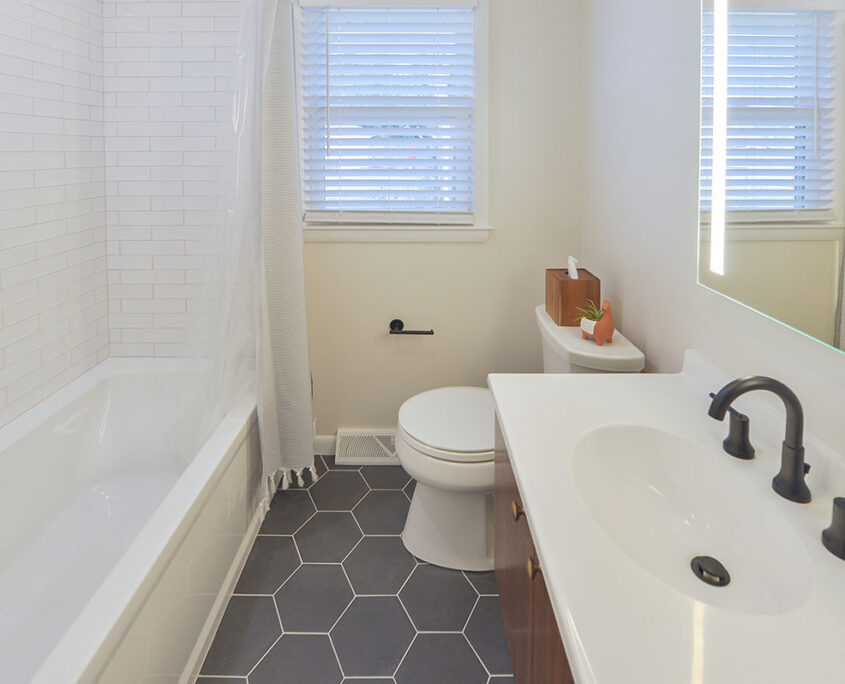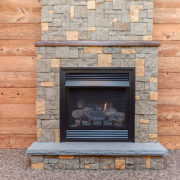Bathroom Vanity Ideas: A Comprehensive Guide
No bathroom is complete without a vanity. Consisting of the bathroom sink and surrounding storage (some definitions include the accompanying mirror and lighting) the ideal vanity combines functionality and style and is a crucial part of any bathroom remodeling project. With that in mind, here’s our comprehensive guide to bathroom vanity ideas.
Space Planning
Before choosing your vanity, you need to know how much space you have in your bathroom. Measure the bathroom’s dimensions and the space between pre-existing fixtures. As a rule of thumb, you should have about 30 inches between major fixtures and walls or other fixtures. The type of bathroom will affect this number, however — you’ll have more room for a vanity of any size in your master bathroom than you will in a half bathroom. Be sure to note the electrical outlets and plumbing fixtures in the room as well.
Size
Your vanity shouldn’t take up an entire wall of your bathroom, nor should it be shoved and hidden in a corner. Instead, choose your vanity according to your needs. Is this vanity for a half bath, or is it a master bathroom? Will you be sharing the bathroom with multiple people simultaneously, such as romantic partners or roommates? Are you hoping for extra counter space and additional storage?
Storage Requirements
On the subject of storage, it’s important to consider the additional storage your vanity could create. This is especially important for vanities for small bathrooms, where storage space is already limited. There are several places you can integrate storage into your vanity if necessary:
Under the Sink
The space under the sink is a common storage choice for many homeowners. It’s often used to hold larger items, such as cleaning supplies and toilet paper. Note that not all vanities are big enough to have a cabinet under the sink.
Vanity Drawers
Drawers are another way to incorporate storage into your vanity. While they don’t offer as much space as a cabinet under the sink, they can hold toothbrushes, hairbrushes, and other personal items. These tend to work better on large vanities, as they require additional space that may not be available in smaller models.
Behind the Mirror
Placing a medicine cabinet behind your vanity’s mirror is an excellent way to incorporate additional storage space into your vanity without needing a larger model. While it won’t hold larger items, such as cleaning supplies or toiletries, it works well for toothpaste, makeup, and pill bottles. Note that this works best with smaller mirrors — it isn’t practical to break up a full-wall mirror for cabinets, after all.
Vanity Style
Once you know the amount of space you have to work with, your next step is determining your vanity’s style. Ideally, your vanity should complement the rest of your decor — as charming as unique bathroom vanities are, that charm is wasted if they clash with the rest of your bathroom. Is your decor traditional? Rustic? Something more modern? Keep the style in mind as you select your vanity’s features.
Countertop Material
Vanity countertops come in a wide variety of materials:
Laminate
Laminate is one of the most common countertop materials. It comes in various colors and designs, is relatively cheap and easy to install, and doesn’t stain easily. It scratches easily, however, and has a short lifespan. It also can’t be repaired beyond shallow scratches.
Solid Surface
Another popular choice, solid surface is durable, stain-resistant, easy to clean, and easy to repair. It does scratch and burn easily, however, and can be damaged by strong chemicals, such as nail polish remover.
Natural Stone
Natural stone, such as granite or quartz, makes for a highly desirable countertop surface. It’s scratch-resistant, heat-resistant, highly durable, and easy to clean, all while increasing your home’s resale value. As a downside, it’s one of the more expensive options, both in installation and maintenance.
Ceramic
Ceramic countertops are versatile and easy to replace when necessary. It’s also one of the cheaper countertop options. Unfortunately, the tiles make for an uneven surface, and ceramic isn’t very durable when compared to other options.
Concrete
A less common countertop material, concrete is extremely durable and easy to repair while providing a strong, dignified look to your counter. However, it does scratch very easily.
Wood
Wooden countertops are a rarity, most likely due to their high maintenance requirements, low durability, and potential for harboring bacteria if not sealed properly. However, when installed and treated correctly, they can provide a uniquely rustic and beautiful appeal to your bathroom.
Stainless Steel
As the name implies, stainless steel countertops are almost impossible to stain or burn. The metal is fully recyclable, and the countertops are easy to install. As a downside, they dent and scratch easily and can be noisy when colliding with pots, pans, and knives.
Sink Options
Next, decide what kind of sink you want in your vanity. There are three main types of sinks:
- Undermount: Undermount sinks are set into the countertop. They’re easy to clean and leave plenty of space on the countertop.
- Vessel: A vessel sink is a sink that sits on the countertop instead of in it. They tend to splash less than undermount sinks and work well as a statement piece in your bathroom.
- Integrated: Similar to undermount sinks, integrated sinks are set inside the counter. The major difference is that integrated sinks are fused to the counter itself. This means they’re made of the same materials as the counter, creating a seamless surface.
In addition to these types, you must also choose between a single or double sink. As the names imply, these vanities come with either one or two sinks. Note that a small bathroom doesn’t necessarily disqualify a double sink — many vanities come with narrow and shallow options to help conserve space.
Faucets and Fixtures
Once you’ve chosen your sink, select the faucets and other fixtures. Just like countertops, faucets come in a wide array of materials:
Brass
Brass is the most popular material for faucets. It has a striking appearance, is durable, and even has microbial properties if left unplated. The biggest concern from brass fixtures is the lead content — while low and rarely an issue, it’s advised to let the water run for a few seconds before use. The bright color of brass faucets can also clash with some bathroom styles.
Stainless Steel
Stainless steel faucets, like stainless steel countertops, are highly durable and stain-resistant. They do tend to be more expensive due to the increased manufacturing difficulty, however.
Zinc/Zinc Alloy
Zinc and zinc alloy faucets serve as a cheaper alternative to brass faucets. While they’re corrosion-resistant, they’re less durable overall.
Plastic
Plastic faucets are the cheapest faucet option available, as well as being entirely lead-free. However, they also feature the lowest durability.
In addition to various core materials, faucets also come in a variety of finishes, such as chrome, stainless steel, gold, silver, and platinum. Make sure the finishes match any other finish present in your bathroom to create a cohesive style.
Lighting
Vanity lighting is an excellent way to add an extra light source to your bathroom. While they can work in any space, they’re an especially good idea for a master bathroom vanity, where the extra room space may warrant extra lighting. This can come in the form of wall sconces or lights mounted directly on the vanity mirror. As always, be sure to match the style to the rest of your bathroom decor.
Mirror and Medicine Cabinet
Your mirror will sit over your vanity. A well-chosen mirror does more than just show you your reflection: it can hide a medicine cabinet, amplify natural lighting, and highlight the rest of your bathroom’s decor. Your mirror should serve both a functional and aesthetic purpose, regardless of whether or not it conceals your medicine cabinet. Combining the two is useful for saving space, but they can function just as well separately.
Budget Considerations
The final decision maker for your vanity choice will always be your budget. As you’re budgeting for your remodel, make sure to allot a reasonable portion towards a vanity and make your choice accordingly. Remember: it may be more expensive to purchase durable materials now, but they’ll save you money in the long run.
Installation
Once you’ve chosen the perfect vanity in your price range, the last step is installation. While you may be tempted to install your vanity yourself, especially if you’ve chosen a smaller model, it’s best to hire a professional. Not only will they ensure the vanity is seamlessly installed in your bathroom, but they’ll also make sure the plumbing and electricity are properly connected.
Conclusion
Selecting the perfect bathroom vanity is a vital part of your bathroom remodel. If you need an installation team you can rely on, contact Ayars. We’ve provided our clients with reliable remodeling solutions since 1970. Our dedication to quality craftsmanship and excellent customer service means you can rest easy knowing your project is in good hands. Contact Ayars today and take the first step towards the bathroom of your dreams.









